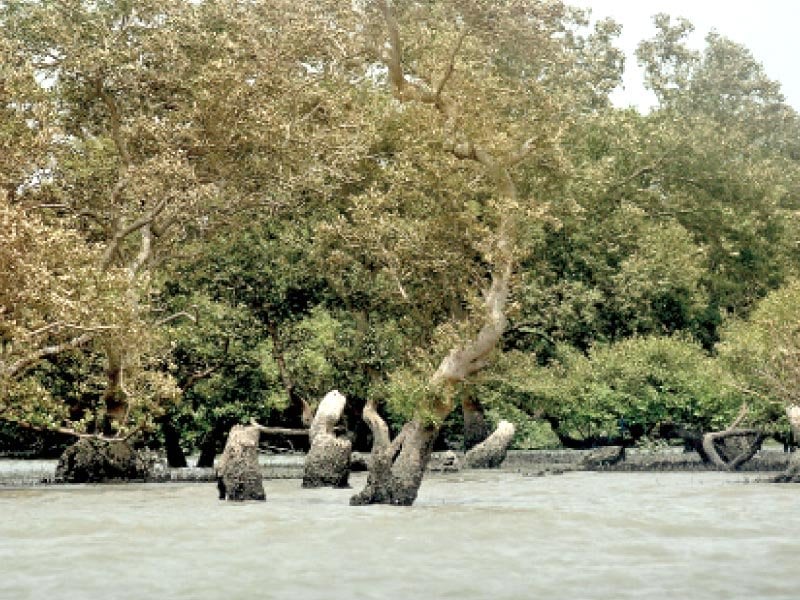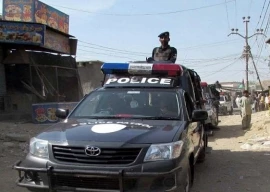
For centuries, Karachi has believed that so long as Abdullah Shah Ghazi’s shrine is kept spotless, the saint would keep storms at bay - after all, he merely had to whisper a warning to the unruly, misbehaving sea in order to calm it down.
But people along the coastal belt say the sea isn’t the only thing which has been misbehaving lately. They claim that the axe-wielding land and timber mafias have hacked away mangroves lining the coast, leaving the city vulnerable to threats brewing at sea. In order to shed light on the problem, the Pakistan Fisherfolk Forum (PFF) recently organised a trip for journalists to the spots, including Dingi and Bhundar islands, where the green cover has fast been vanishing.
While talking to The Express Tribune, Zakir Hussain, a former fisherman, said, “Tsunamis have become a real threat for Karachi.” He added that as mangrove trees were chopped, a lot of other problems cropped up for fishermen. He said he had stopped fishing eight years ago as he simply couldn’t catch enough to feed his family. Zakir added that things hadn’t always been so bleak - there were plenty of fish to go around for everyone and heaps of money to earn from the activity.

“My father used to earn enough to feed our family. He never gave me permission to tag along, telling me that my place was in the classroom,” said Zakir. “But things changed when I was in the eighth grade. I skipped school to lend my father a hand and then I had to abandon fishing altogether because I couldn’t earn enough to support my family.”
Like the other villagers, he pinned the problem on the timber and land mafias. “They’re destroying mangrove forests with the help of influential people in the area. They’re sometimes abetted by government officials,” he claimed.
“Karachi’s residents must realise that apart from being a breeding ground for fish and the place where migratory birds court each other, mangrove forests also form a defensive wall against storms. The stems and roots of the trees absorb the shock of tides, reducing their intensity.”
Sami Memon, the general secretary of the Pakistan Fisherfolk Forum, said that the area covered by mangrove forests has plummeted from 600,000 hectares in 1930s to just 86,000 hectares in 2005.
“The mafia still cuts mangroves, reclaims land and sells it off for commercial use,” he said, claiming that this activity is rampant along the entire coast of Karachi.
Talib Kusshi, PFF’s general secretary, said that mangroves play a significant role in the lives of the coastal communities, all of whom depend on the trees for survival. “The livelihoods of all villagers are both directly and indirectly dependent on mangroves.”
But the land and timber mafias aren’t the only problems. As the population has swelled, industrial activity has spiraled to, presenting a new threat to the mangrove forests. “Every year, around 90,000 tonnes of oil product are dumped from vessels and ports into the sea.”
Only on paper?
According the Climate Change Policy 2012, mangroves must be protected and planted along the coast to prevent soil erosion and to minimise the disastrous impact of cyclones and tsunamis. The National Forest Policy 2002 also states that mangrove forests should be cared for as they are vital for protecting the coast and are an important habitat for fishes and shrimps.
Published in The Express Tribune, June 21st, 2013.
COMMENTS (4)
Comments are moderated and generally will be posted if they are on-topic and not abusive.
For more information, please see our Comments FAQ

1731329418-0/BeFunky-collage-(39)1731329418-0-165x106.webp)



1731737597-0/Untitled-design-(12)1731737597-0-270x192.webp)
1731746071-0/Untitled-design-(11)1731746071-0-270x192.webp)
1731749026-0/Copy-of-Untitled-(3)1731749026-0-270x192.webp)









IT is ironic that 2011 was declared by the UN as the "International Year of the Forest", This was also the year when the land mafia murdered by drowning 2 fishermen who were trying to save the mangrove forests in Karachi's Sandspit area from destruction. The brave fishermen who gave their lives for trying to save the mangroves were Abdul Ghani, and his colleague Haji Abu Bakr.
what we did in last sixty years just look it this queen road and Victoria road were full of trees one cant even see the sun light during day now its feel like sub Saharan roads and native trees of indopak like neem and peepal u hardly see any where in krachi.
What isn't being destroyed in Karachi? Destruction of nature. Just one more sad and disappointing chapter in the book of Karachi. A city that has it all and could be one of the great successful cities of the world. Instead, the powers that be are allowing this city of potential riches to be raped piece by piece unabated. A law and order and anti-corruption crackdown on every single.level needs to be implemented without delay. Pakistan needs to enter the 21st century before it is too late.
This was a ecological disaster in the making, Since 1947 we have never carried out detailed geographical surveys. We buy survey maps from NASA and other agencies, but have never done our own. British had a fetish about it. When Kemari and Karachi harbour was charted and constructed after 1839 the mangroves were a natural breakwater for sea intrusion into the port that was under construction and the two bridges build connecting the wharfs. Click below for details. http://en.wikipedia.org/wiki/PortofKarachi
Glasgow University has an Institute that goes bio-diversity research all over the world but specifically on the Indus Delta. See research papers presented by both Pakistani professionals and others in the UK. http://www.gla.ac.uk/researchinstitutes/bahcm/researchfacilitiesgroups/biosedimentology/riversmountains/indusriver/ It painfully points out the fragility of our ecological environment and the risks it poses to birds, mammals, fishes and vegetation. Sadly, even though we have Pakistani professionals who know what risks we face, somehow Mai Kolachi and its surrounding mangroves have been permanently destroyed. For what, one should ask?